As the site is updated, each listing includes the shipping cost. Some listings which I have not updated still give you calculated shipping costs based on weight and size of package. (In the sections I have updated) If you select several different listings, we will consolidate your order and charge you the actual cost of the entire package. The shipping over charge will be refunded to you, when your order is shipped.
ONE OF THE LARGEST SELECTIONS OF QUALITY ABALONE SHELLS ON THE NET
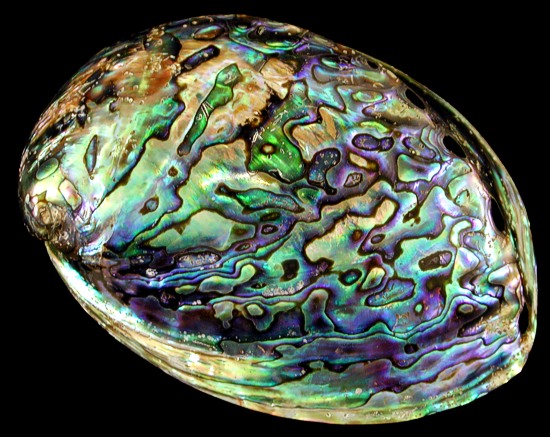
Haliotis Iris Paua
FREE SHIPPING
M1-4
One 4 to 5 inch Polished Paua Abalone (Haliostis Iris) from Northern shores of New Zealand...$19.95
Pāua is the Māori name given to three New Zealand species of large edible sea snails, marine gastropod molluscs which belong to the family Haliotidae (in which there is only one genus, Haliotis).
There are three species of New Zealand pāua:
The Haliostis Iris or blackfoot paua are the most common. They can grow to a 7 inch width.
Queen pāua also referred to as Haliotis australis, Silver pāua, yellowfoot pāua, hihiwa & karariwha
Virgin pāua also known as Haliotis virginea, Whitefoot pāua, marapeka and kolo
Genus is a Latin word that means birth, race, kind and is used to describe a class, kind, or group of things with common characteristics or one common trait.
Māori commonly shortened to te reo, is an Eastern Polynesian language spoken by the Māori people, the indigenous population of mainland New Zealand.
It is known in the United States and Australia as abalone, and in the United Kingdom as ormer shells. In New Zealand, these are known as pāua, which (as is common with all Māori words) is both singular and plural.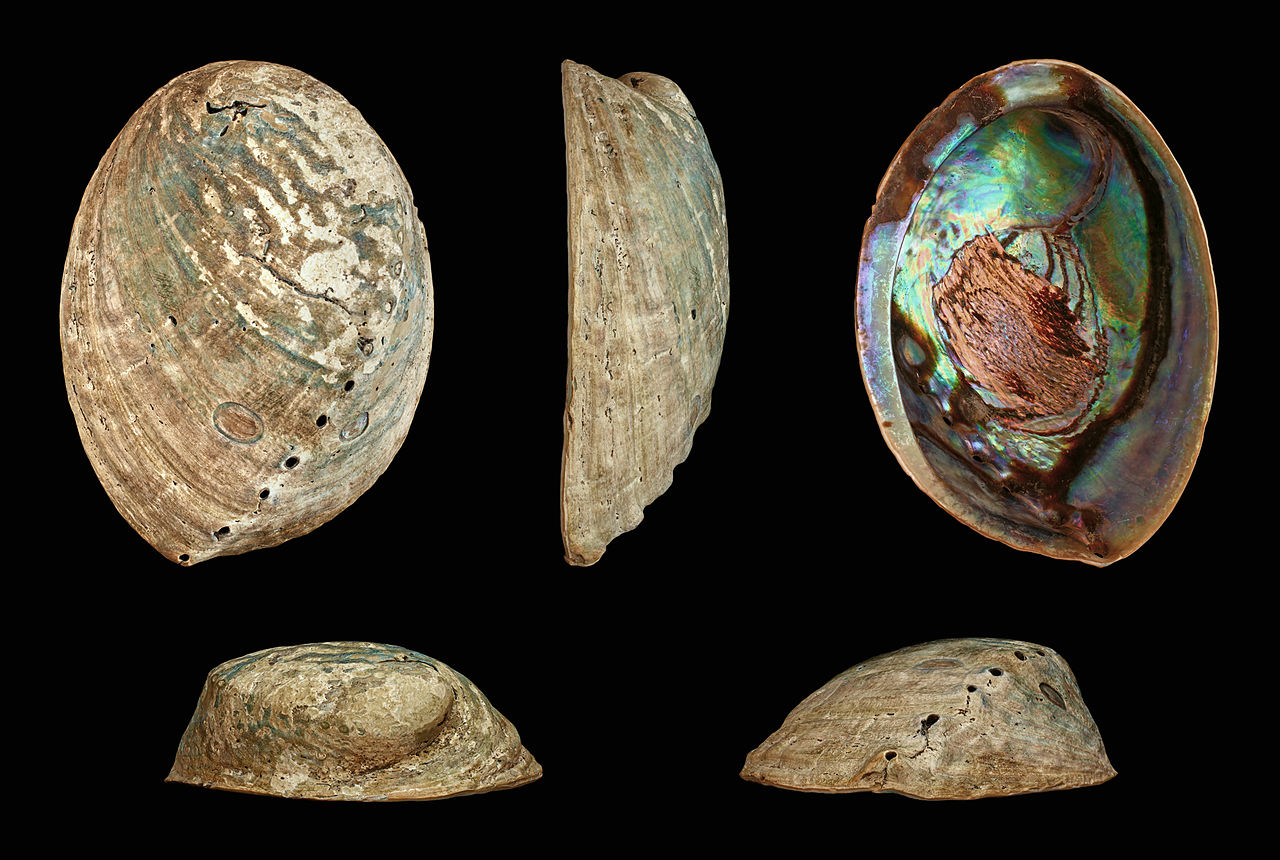
Haliostis Iris or blackfoot paua
Haliotis iris is a farmed species of pāua found in New Zealand. That is mainly because of its size compared to its smaller relatives - the "yellowfoot pāua" and the even smaller "virgin paua" - which are also commonly used for jewelry arts and carvings around New Zealand.
The common size of the shell of this species varies between 3 to 6 inches. The two sides of the oval, convex shell are equally curved. The oblique spire is very short and contains two whorls and five to seven perforations. The surface is pitted. The lip is continuous and is produced beyond the body whorl. The inner surface is dark metallic blue and green, with yellow reflections. The muscle impression is distinct and roughened. The back of the shell is convex and angled at the row of perforations. The outer surface is pale brown or light olive-green, pitted as if by the intersection of two series of low oblique folds. The inside of the spire is brilliantly pearly, prussian blue and green predominating, but with reflections also of purple, orange and a little red. The columellar plate is broad, passing into the expanded continuation of the outer lip above. It is not truncate below. Its face is flattened, and slopes inward. The cavity of the spire is small.
Scientific classification
Domain: Eukaryota
Kingdom: Animalia
Phylum: Mollusca
Class: Gastropoda
Subclass: Vetigastropoda
Order: LepetellidaFamily: Haliotidae
Genus: Haliotis
Species: Haliotis iris
Binomial name: Haliotis iris
Gmelin, 1791
(REF:Geiger D.L. & Poppe G.T. (2000). A Conchological Iconography: The family Haliotidae. Conchbooks, Hackenheim Germany)(REF:Somerville, Gayle (2013) "Exploring harvest regulations of the New Zealand paua abalone (Haliotis iris) via population modelling )(REF: "Haliotis (Paua) iris". Gastropods.com.)
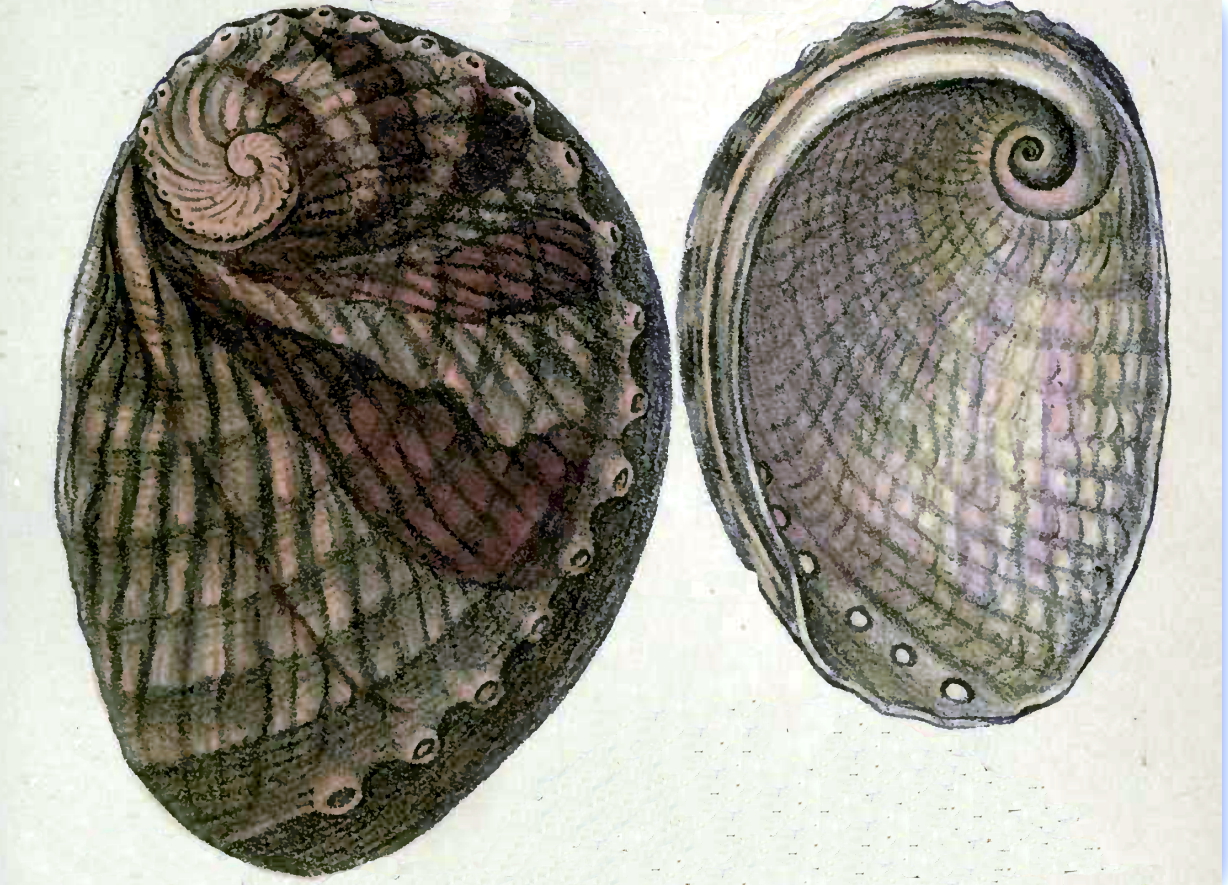
Haliotis Australis
Haliotis Australis common name the queen pāua, yellowfoot pāua, or austral abalone.
These are edible sea snails, a marine gastropod mollusk in the family Haliotidae, the abalones.
The average size of the Haliotis Australis shell varies between 1.5 to 4 inches. The convex shell is thin and oval shaped. The distance of the apex from margin measures one-eighth to one-ninth the length of the shell. The sculpture consists of faint spirals and a close strong radiating corrugation. The 6 to 8 perforations are circular with elevated edges. The outlines are oval. The right margin is a little straighter. The back of the shell is convex, not carinated at the row of holes. The color pattern is light yellowish-brown, red on the spire, or light green flamed with red. The surface has almost obsolete spiral cords, and regular, close, radiating folds. Between the row of holes and the columellar margin. There are no radiating folds, but several (generally three) strong spiral ribs. The spire is a little elevated and contains three whorls .Inside it is corrugated like the exterior, silvery with blue, green and red reflections, the latter predominating. The columellar plate is narrow.
The corrugated exterior is constant and characteristic. Young specimens are strongly ribbed spirally, and often have radiating stripes of red on a delicate green ground.
Haliotis Australis dwell in the tropical sea that surrounds New Zealand.
Haliotis australis also known as Queenies. They are also referred to paua as the other two Haliotis species in New Zealand. These paua abalones are locally used as a food source. They are generally smaller than their Haliotis iris counterparts. The Haliotis Australis after reaching a minimum length of 3.2 inches can be harvested.

Scientific classification
Domain: Eukaryota
Kingdom: Animalia
Phylum: Mollusca
Class: Gastropoda
Subclass: Vetigastropoda
Order: Lepetellida
Family: Haliotidae
Genus: Haliotis
Species: Haliotis australis
Binomial name: Haliotis australis
Gmelin, 1791
(REF:Evans, H.J.N.; Peters, H. (2021). "Haliotis australis". IUCN Red List of Threatened Species. 2021:)(REF: WoRMS : Haliotis australis; accessed : 5 October 2010)(REF: Industries, Ministry for Primary. "Pāua | MPI - Ministry for Primary Industries. A New Zealand Government Department")(REF: H.A. Pilsbry (1890) Manual of Conchology XII; Academy of Natural Sciences, Philadelphia, 1890 (described as Haliotis rugosoplicata))
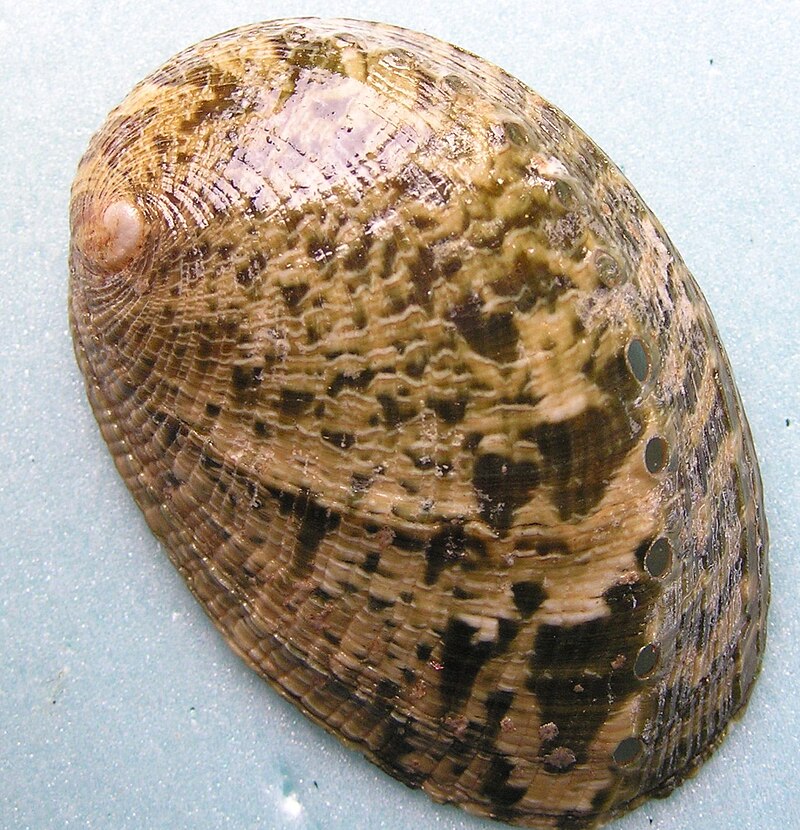
Haliotis virginea
The Virgin pāua is a species of edible sea snails, a marine gastropod mollusk in the family Haliotidae, the abalones.
The average size of the Virgin paua shell varies between 1 to 3 inches.
They dwell in the tropical sea that surrounds New Zealand and some are found around Rocky Reefs in the Subtidal zone. They are nocturnal and inhabits the under-side of boulders and crevices. These are the deepest living pāua having been found at depths of 98 feet and are rarely found intertidally.This is a small paua, which has a thin finely sculptured shell. It has a small spire with 2-3 whorls. The sculpturing is made of dense spiral lines that may be crossed by small radial folds. The shells are not usually encrusted. The exterior of the shell is light reddish brown with greenish stripes. The interior of the shell has a brilliant iridescence which is predominantly red or green. The animal is pale with a white foot.
The Virgin Paua graze on algae that cling to rocks and drifting seaweed.
This is the least common species of paua abalone found in New Zealand but the most widely distributed. It is thought to be too small and rare for collecting or harvesting.
Scientific classification
Domain: Eukaryota
Kingdom: Animalia
Phylum: Mollusca
Class: Gastropoda
Subclass: Vetigastropoda
Order: Lepetellida
Family: Haliotidae
Genus: Haliotis
Species: Haliotis virginea
Binomial name: Haliotis virginea
Gmelin, 1791
(REF: Evans, H.J.N.; Peters, H. (2021). "Haliotis virginea". IUCN Red List of Threatened Species. 2021)(REF: Rosenberg, G. (2012). Haliotis virginea Gmelin, 1791. Accessed through: World Register of Marine Species )(REF: Walton, Kerry; Scarsbrook, Lachie; Mitchell, Kieren J.; Verry, Alexander J. F.; Marshall, Bruce A.; Rawlence, Nicolas J.; Spencer, Hamish G. (2023)(REF: Geiger D.L. & Poppe G.T. (2000). A Conchological Iconography: The family Haliotidae. Conchbooks, Hackenheim Germany)(REF: Geiger D.L. & Owen B. (2012) Abalone: Worldwide Haliotidae. Hackenheim: Conchbooks)
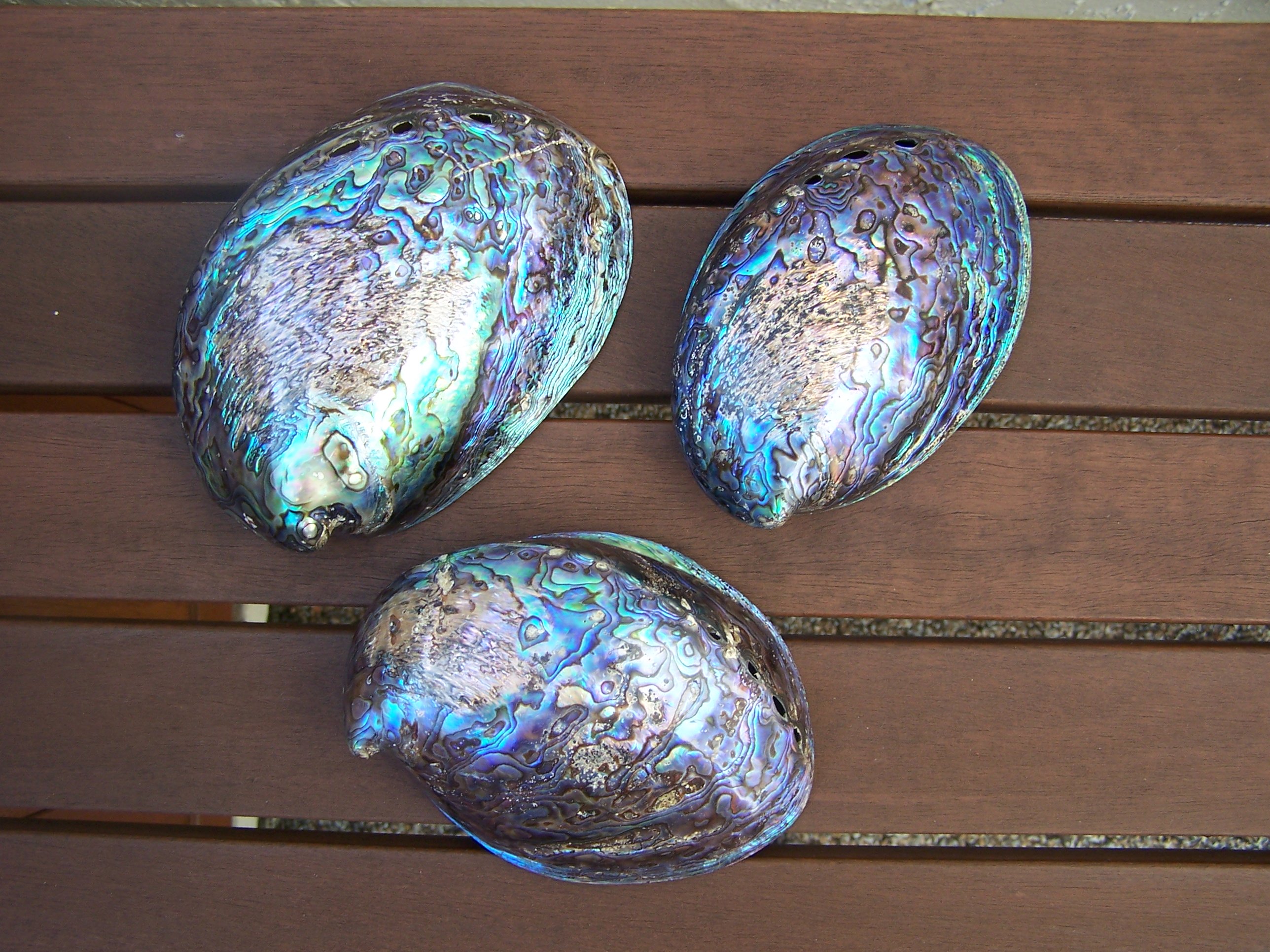
SCAREFACE PAUA ABALONE
Highly polished Scareface Paua Abalones from the tropical sea surrounding New Zealand.
SFPAB
One 4 to 5 inch highly polished Scareface Paua Abalone (Haliostis Iris).... $16.95
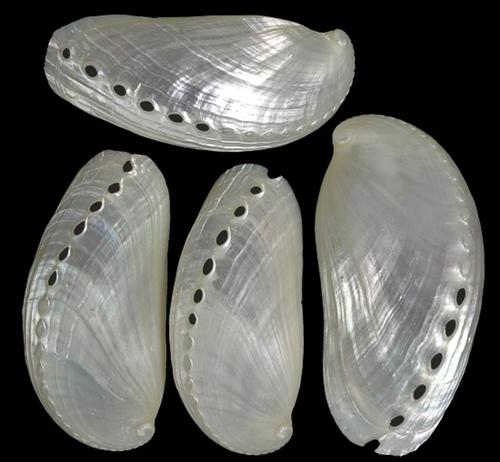
L3-14
Five Polished Pearl Abalones measuring at least 1 inch .... $3.95
L2-14
Five Polished Pearl Abalones measuring at least 2 inches .... $5.75
L1-14
Five polished Pearl Abalone shell measuring at least 3 inches....... $5.95
Haliotis Asinina These are polished down to their mother of pearl
common name the Mule Earl Abalone, is a fairly large species of sea snail, a tropical gastropod mollusk in the family Haliotidae, the abalones, also known as ormers or pāua. Both the common name and the scientific name are based on the shape of the shell, which is long, narrow and curved, resembling the shape of a donkey's ear.
The shell length of this species have been found up to 4 3/4 inches. The average shell size is approximately grows up to about 3 1/2 inches. The shell of Haliotis asinina has a distinctly elongated contour, in clear resemblance to a donkey ear. Its outer surface is smooth and almost totally covered by the mantle in life, making encrustations of other animals (such as barnacles) uncommon in comparison to other abalones. The shell of Haliotis asinina presents 5 to 7 ovate open holes on the left side of the body whorl. These holes collectively make up what is known as the selenizone which form as the shell grows. Its spire is has a mostly posterior apex. The color may vary between green olive or brown externally, with distinct roughly triangular patches. As is the case in many other abalones, the interior surface of the shell is strongly iridescent, with shades of pink and green.
This is an Indo-West Pacific species (Eastern Indian Ocean to the Central Pacific). They are common in the Andaman Islands and Nicobar Islands, Pacific islands, southern Japan and Australia (Northern Territory, Queensland, Western Australia).
This abalone species are found in shallow water coral reef areas of the intertidal and sublittoral zones, commonly reaching a depth around 33 feet. This species is common, but large clusters of Haliotis asinina are considered a rare occurrence.
These abalones are nocturnal (active at night). They graze amongst turf algae and inhabit the undersides of boulders and coral bommies.
bommiean outcrop of coral reef, often resembling a column, that is higher than the surrounding platform of reef and which may be partially exposed at low tide.
Several major transitions in shell pattern and morphology can be observed during the life of Haliotis asinina. This species has a pelagobenthic life cycle that includes a minimal period of three to four days in the plankton. Biomineralisation begins shortly after hatching, with the fabrication of the larval shell (protoconch) over about a 10-hour period. The initial differentiation of biomineralising cells is likely to include a localised thickening of the dorsal ectoderm followed by an invagination of cells to form the shell gland. The shell gland then evaginates to form the shell field which expands through mitotic divisions to direct the precipitation of calcium carbonate (CaCO3) via the secretion of organic molecules. In this way the larval shell (protoconch) is formed. The construction of the haliotid protoconch is complete following torsion. These structures allow the veliger larva to completely retract into a protective environment and rapidly fall out of the water column.
Morphology is the study of the shapes and arrangement of parts of organisms, words, or rocks.
The pelagobenthic is the description of a life cycle which are found throughout the animal kingdom, and includes gametogenesis, embryogenesis, and metamorphosis.
Biomineralization is the process by which living organisms produce minerals. Biomineralization processes often lead to the hardening or stiffening of the mineralized materials. This includes the formation of silicates in algae and diatoms, carbonates in invertebrates, and calcium phosphates and carbonates in the hard tissues of vertebrates.
The next phase of biomineralisation does not commence until the competent veliger larva contacts an environmental cue that induces metamorphosis. The protoconch remains developmentally inert until the animal contacts a specific cue that initiates the process of metamorphosis.
Metamorphosis is a biological process by which an animal physically develops including birth transformation or hatching, involving a conspicuous and relatively abrupt change in the animal's body structure through cell growth.
The postlarval shell (teleoconch) is laid down rapidly following metamorphosis with marked variation in the rate of its production between individuals. The transition from protoconch to teleoconch (juvenile/adult shell) is clearly visible at metamorphosis, and suggests the action of a different biomineralising secretome. The early postlarval shell is more robust and opaque than the larval shell but has no pigmentation. While the initial teloconch is not pigmented, it is textured and opaque such that postlarval shell growth is easily discerned from the larval shell.
pigmentation is the natural color of something, usually a living thing.
The juvenile Haliotis asinina teloconch rapidly develops a uniform maroon coloration several weeks after metamorphosis, similar to the crustose coralline algae (CCA) that the larva has settled upon. At about 1/4 inch in size, further changes in the morphogenetic program of the mantle are reflected in the shell. Structurally, a pronounced series of ridges and valleys and a line of respiratory pores (tremata) have appeared. It is at this stage of development that the first recognizable tablets of nacre (mother of pearl) can be detected. Colormetrically, the uniform maroon background is now interrupted by oscillations of a pale cream color, and is punctuated by a pattern of dots (that only occur on ridges) these are blue when overlying a maroon field and orange when overlying a cream field. The shell pattern may enhance the juvenile's ability to camouflage on the heterogeneous background of the CCA they inhabit at this stage of development.
This pattern is gradually lost with growth, as the shell becomes thicker and more elongate. At 1/4 to 1/2 inches, this ornate coloration pattern begins to fade, with maroon and cream fields apparently blending to give a brown background. Blue and orange dots continue persist on the ridges.
As the shell grows, the ridge-valley structure fades to give rise to a smooth adult shell, with irregular brown-green triangles on a light brown background. These large scale morphological changes are accompanied by mineralogical and crystallographic changes. Well defined tablets of nacre are present in shells larger than approximately 5 mm which are absent or poorly resolved in shells 1/4 inch or less. In larger shells, a ventral cap of CaCO3 that underlies the tablets of aragonitic nacre continues to thicken.
The ontogenetic changes in Haliotis asinina shell pigmentation and structure match changes in the habitats occupied during development.
ontogenetic of or relating to the origin and development of individual organisms.
The growth rate of Haliotis asinina is the fastest of all the abalones. Individuals reach sexual maturity in about one year.
Scientific classification
Domain: Eukaryota
Kingdom: Animalia
Phylum: Mollusca
Class: Gastropoda
Subclass: Vetigastropoda
Order: Lepetellida
Family: Haliotidae
Genus: Haliotis
Species: Haliotis asinina
Binomial name: Haliotis asinina
Linnaeus, 1758
(REF: Peters, H. (2021). "Haliotis asinina". IUCN Red List of Threatened Species. 2021)(REF: Haliotis asinina Linnaeus, 1758. Retrieved through: World Register of Marine Species on 29 March 2010)(REF: Haliotis asinina Donkey's ear abalone. Sealifebase.org accessed 10 July 2009)(REF: Poutiers, J. M. (1998). Gastropods in: FAO Species Identification Guide for Fishery Purposes: The living marine resources of the Western Central Pacific Volume 1)(REF: Jackson D. J., Wörheide G. & Degnan B. M. (2007). "Dynamic expression of ancient and novel molluscan shell genes during ecological transitions". BMC Evolutionary Biology 7)(REF:Lucas T., Macbeth M., Degnan S. M., Knibb W. R. & Degnan B. M. (2006). "Heritability estimates for growth in the tropical abalone Haliotis asinina using microsatellites to assign parentage". Aquaculture 259)(REF:Jackson D. J., McDougall C., Green K., Simpson F., Wörheide G. & Degnan B. M. (2006). "A rapidly evolving secretome builds and patterns a sea shell". BMC Biology 4: 40)(REF: Donovan, E. 1808. Conchology. In, The new Cyclopaedia or Universal Dictionary of Arts and Sciences )(REF: Geiger, D.L. & Poppe, G.T. 2000. A Conchological Iconography. The family Haliotidae. Germany : ConchBooks )(REF: Streit, K., Geiger, D.L. & Lieb, B. 2006. Molecular phylogeny and the geographic origin of Haliotidae traced by haemocyanin sequences. Journal of Molluscan Studies
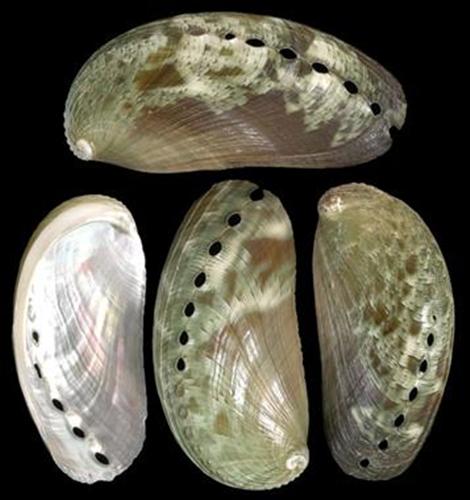
K1-14
Five Green Abalones, measuring 2 to 3 inches. ...... $4.50
K3-14
5 1 to 1.5 inch Green Abalones ...... $3.69
Haliotis Asinina Green Abalone
Common name Mule Ear Abalone
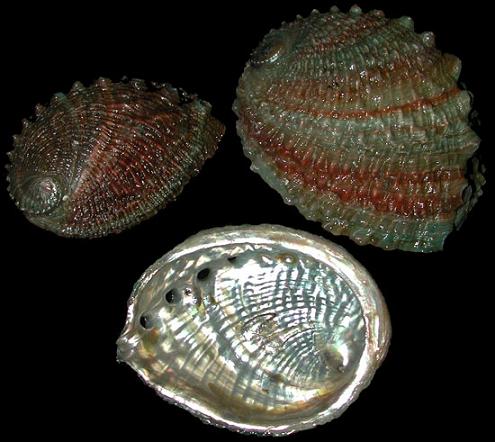
Ruff Back Rainbow Abalone
Rainbow Ruff Backs are found near the Mexican coast. They are naturally rough on the outside and pearlized inside.
PAB1-2-5
One Ruff Back Rainbow Abalone, measuring 4 to 6 inches.....$8.59
Haliotis Rufescens
Common name red abalone is a large edible sea snail species in the family Haliotidae, the abalones, ormers (British) or pāua. It is distributed from British Columbia, Canada, to Baja California, Mexico. It is most common in the southern half of its range.
The Red abalone is the largest and most common abalone found in the northern part of the state of California.
The red abalone's shell length can reach a maximum of 12 inches, making it the largest species of abalone in the world.
The Red Abalone shell is large, thick, dome-shaped, and usually covered with barnacles, vegetation, or other marine growth making the color and shell sculpture difficult to determine. It is usually a dull brick red color externally. Typically the shell has three to four slightly raised oval holes or respiratory pores, although specimens with no holes and others with more than four have been found. These holes collectively make up what is known as the selenizone which form as the shell grows. The inside of the shell appears polished and is strongly iridescent. A central, prominent muscle scar is easily visible in the shells of most Red Abalone, marking the location at which Haliotis Rufescens's strong columellar muscle attaches.Below the edge of the shell, the black epipodium and tentacles can be seen. The underside of the foot is yellowish white in color.
The epipodium is one of the lateral lobes of the foot (structure used for locomotion or attachment) in abalones.
A lobe is a rounded projection that is part of a larger structure (the foot)
Female members of dioecious molluscan species (red abalones) have been known to be more common than males. In populations that experience human predation, this difference can be exacerbated, as is the case with populations of Haliotis rufescens. From 1972-1973, researchers studying red abalone populations at Point Cabrillo Lighthouse Station and Van Damme State Park found that the level at which human predation occurs can have profound effects on the age class structure of each population. For many years, the abalone at Van Damme were heavily fished and the population structure reflected a notable lack of larger, older individuals. At Point Cabrillo, however, abalone harvesting had been halted for some time, and populations of red abalone showed the development of a natural age class structure and sex ratio.
Dioecious reproduction is biparental reproduction. Dioecy has costs, since only the female part of the population directly produces offspring. It is one method for excluding self-fertilization and promoting allogamy (outcrossing), and thus tends to reduce the expression of recessive deleterious mutations present in a population.
Because of the destruction of most wild populations, abalone farming has become a booming business. Unlike some aquaculture operations, the farming of abalones is considered to be a form of sustainable agriculture. Few chemicals are used in the process and the abalones are fed locally harvested kelp and algae, which promptly grows back in abundance.
In 1916, documentation of the modern California fishery began. Fishing for these abalone populations peaked in the 1950s and 1960s and was followed by a decline in all five abalone species, red, green, pink, white, and black. Prior to this point, the fishery seemed sustainable with the increase in species that could be fished and the expansion of fishing areas. Disease and the recovery of sea otter populations contributed to the decline of the abalone, and the California Fish and Game Commission ended fishing for abalone in 1997.
In Northern California, commercial fishing was only legal for three years during World War II. As a result, a recreational fishery still exists in northern California. Scuba diving to harvest abalones is banned, the fishery consists of shore pickers searching the rocks at low tide, and free divers using breath-hold diving to search for them. This creates a reserve for the abalone in the water below 30 feet, where few divers are skilled enough to go. Currently, the minimum legal size is 7 inches, but a moratorium has been in effect since 2017.
Scientific classification
Domain: Eukaryota
Kingdom: Animalia
Phylum: Mollusca
Class: Gastropoda
Subclass: Vetigastropoda
Order: Lepetellida
Superfamily: Haliotoidea
Family: Haliotidae
Genus: Haliotis
Species: Haliotis rufescens
Binomial name: Haliotis rufescens
Swainson, 1822
(REF:Lindberg, D. R. 1992. Evolution, distribution and systematics of Haliotidae. Pp 3–18 in: S. A. Shepherd, M. Tegner, and S. A. Guzman, eds. Abalone of the world: biology, fisheries and culture. Blackwell Scientific, Oxford.)(REF: Peters, H., Rogers-Bennett, L. & De Shields, R.M. (2021). "Haliotis rufescens". IUCN Red List of Threatened Species.)(REF: Rosenberg, G. (2014). Haliotis rufescens Swainson, 1822. Accessed through: World Register of Marine Species)(REF:Cowles, D. (2005). Haliotis rufescens. Archived 2015-02-25 at the Wayback Machine Biological Department, Walla Walla University.)(REF: Red Abalone Fishery Management Plan. California Department of Fish and Wildlife.)(REF: Giorgi, A. E.; DeMartini, John D. (1977). "A study of the reproductive biology of the red abalone, Haliotis rufescens Swainson, near Mendocino, California)(REF:Bailey, K. M. Monterey Bay abalone farm shows what sustainable aquaculture can be like. Earth Island Journal)(REF: "Marine Protected Areas in Central California and Potential Benefits to Selected Species: Abalone" (PDF). California Department of Fish and Game.)(REF: Haliotis (Haliotis) rufescens. Hardy's Internet Guide to Marine Gastropods)
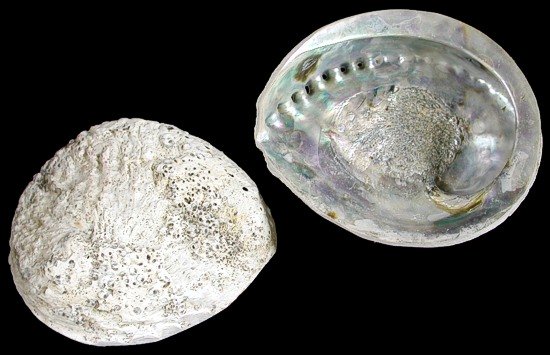
Silver Abalone ruff back
The color of the shell is very variable from species to species, which may reflect the animal's diet. The iridescent nacre that lines the inside of the shell varies in color from silvery white, to pink, red and green-red to deep blue, green to purple.
B1-37
One Silver Ruff Back Abalone measuring 3.5 to 5.5 inches..... $7.59
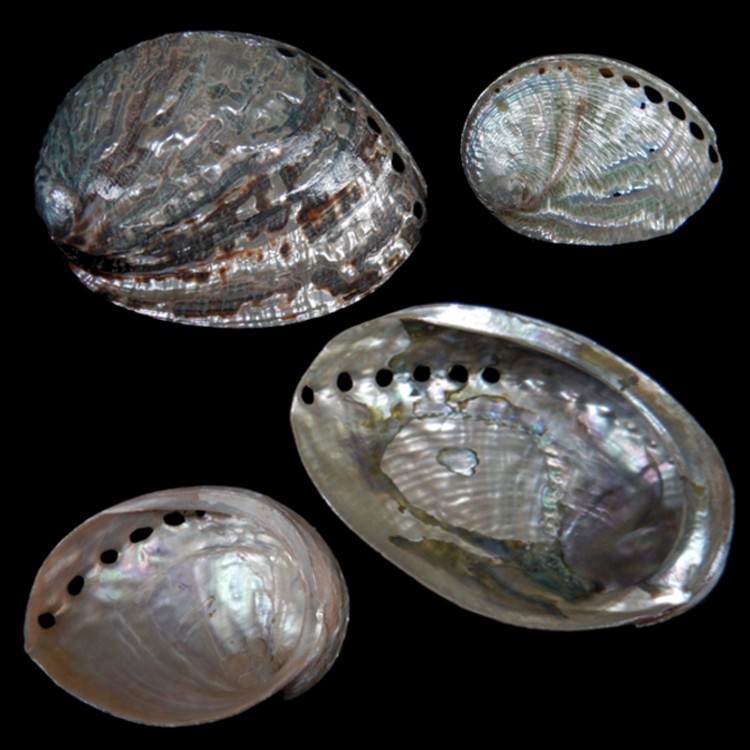
PEARL Silver GREEN ABALONE
PAP7-4
One Silver Green Abalone measuring 3.5 to 4 inches..... $5.95
PAP8-4
One Silver Green Abalone measuring at least 5 inches ..... $9.65
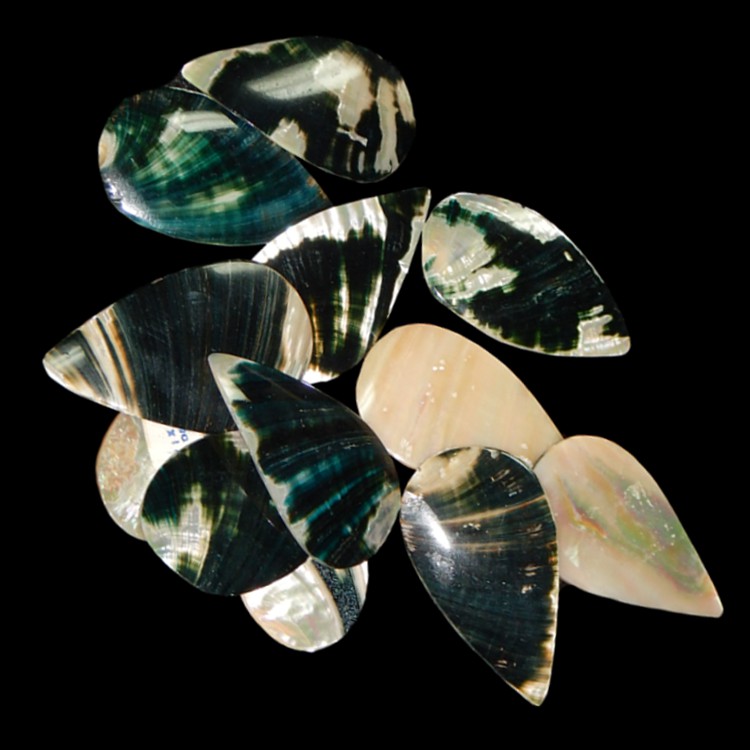
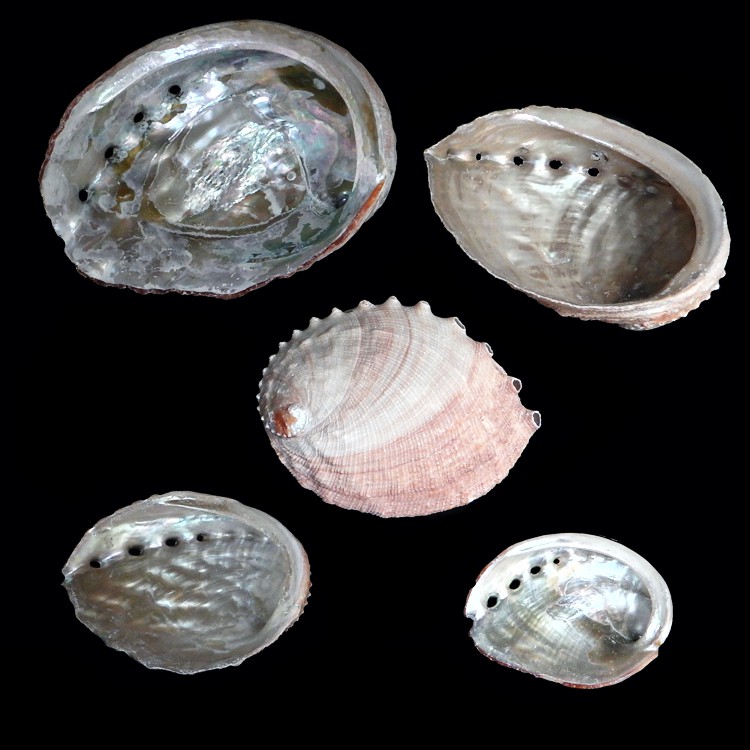
Red Abalone
RA1-5
One Red Abalone measuring 3 to 5 inches..... $7.59
RA2-5
One Red Abalone measuring 5 to 7 inches.....OUT OF STOCK $4.80
RA3-5
One Red Abalone measuring 7 to 9 inches....$15.95
Haliotis Rufescens
Common name red abalone is a large edible sea snail species in the family Haliotidae, the abalones, ormers (British) or pāua. It dwells from British Columbia, Canada, to Baja California, Mexico. It is most common in the southern half of its range.
The Red abalone is the largest and most common abalone found in the northern part of the state of California.
The red abalone's shell length can reach a maximum of 12 inches, making it the largest species of abalone in the world.
The Red Abalone shell is large, thick, dome-shaped, and usually covered with barnacles, vegetation, or other marine growth making the color and shell sculpture difficult to determine. It is usually a dull brick red color externally. Typically the shell has three to four slightly raised oval holes or respiratory pores, although specimens with no holes and others with more than four have been found. These holes collectively make up what is known as the selenizone which form as the shell grows. The inside of the shell appears polished and is strongly iridescent. A central, prominent muscle scar is easily visible in the shells of most Red Abalone, marking the location at which Haliotis Rufescens's strong columellar muscle attaches.Below the edge of the shell, the black epipodium and tentacles can be seen. The underside of the foot is yellowish white in color.
The epipodium is one of the lateral lobes of the foot (structure used for locomotion or attachment) in abalones.
A lobe is a rounded projection that is part of a larger structure (the foot)
Female members of dioecious molluscan species (red abalones) have been known to be more common than males. In populations that experience human predation, this difference can be exacerbated, as is the case with populations of Haliotis rufescens. From 1972-1973, researchers studying red abalone populations at Point Cabrillo Lighthouse Station and Van Damme State Park found that the level at which human predation occurs can have profound effects on the age class structure of each population. For many years, the abalone at Van Damme were heavily fished and the population structure reflected a notable lack of larger, older individuals. At Point Cabrillo, however, abalone harvesting had been halted for some time, and populations of red abalone showed the development of a natural age class structure and sex ratio.
Dioecious reproduction is biparental reproduction. Dioecy has costs, since only the female part of the population directly produces offspring. It is one method for excluding self-fertilization and promoting allogamy (outcrossing), and thus tends to reduce the expression of recessive deleterious mutations present in a population.
Because of the destruction of most wild populations, abalone farming has become a booming business. Unlike some aquaculture operations, the farming of abalones is considered to be a form of sustainable agriculture. Few chemicals are used in the process and the abalones are fed locally harvested kelp and algae, which promptly grows back in abundance.
In 1916, documentation of the modern California fishery began. Fishing for these abalone populations peaked in the 1950s and 1960s and was followed by a decline in all five abalone species, red, green, pink, white, and black. Prior to this point, the fishery seemed sustainable with the increase in species that could be fished and the expansion of fishing areas. Disease and the recovery of sea otter populations contributed to the decline of the abalone, and the California Fish and Game Commission ended fishing for abalone in 1997.
In Northern California, commercial fishing was only legal for three years during World War II. As a result, a recreational fishery still exists in northern California. Scuba diving to harvest abalones is banned, the fishery consists of shore pickers searching the rocks at low tide, and free divers using breath-hold diving to search for them. This creates a reserve for the abalone in the water below 30 feet, where few divers are skilled enough to go. Currently, the minimum legal size is 7 inches, but a moratorium has been in effect since 2017.
Scientific classification
Domain: Eukaryota
Kingdom: Animalia
Phylum: Mollusca
Class: Gastropoda
Subclass: Vetigastropoda
Order: Lepetellida
Superfamily: Haliotoidea
Family: Haliotidae
Genus: Haliotis
Species: Haliotis rufescens
Binomial name: Haliotis rufescens
Swainson, 1822
(REF:Lindberg, D. R. 1992. Evolution, distribution and systematics of Haliotidae. Pp 3–18 in: S. A. Shepherd, M. Tegner, and S. A. Guzman, eds. Abalone of the world: biology, fisheries and culture. Blackwell Scientific, Oxford.)(REF: Peters, H., Rogers-Bennett, L. & De Shields, R.M. (2021). "Haliotis rufescens". IUCN Red List of Threatened Species.)(REF: Rosenberg, G. (2014). Haliotis rufescens Swainson, 1822. Accessed through: World Register of Marine Species)(REF:Cowles, D. (2005). Haliotis rufescens. Archived 2015-02-25 at the Wayback Machine Biological Department, Walla Walla University.)(REF: Red Abalone Fishery Management Plan. California Department of Fish and Wildlife.)(REF: Giorgi, A. E.; DeMartini, John D. (1977). "A study of the reproductive biology of the red abalone, Haliotis rufescens Swainson, near Mendocino, California)(REF:Bailey, K. M. Monterey Bay abalone farm shows what sustainable aquaculture can be like. Earth Island Journal)(REF: "Marine Protected Areas in Central California and Potential Benefits to Selected Species: Abalone" (PDF). California Department of Fish and Game.)(REF: Haliotis (Haliotis) rufescens. Hardy's Internet Guide to Marine Gastropods)
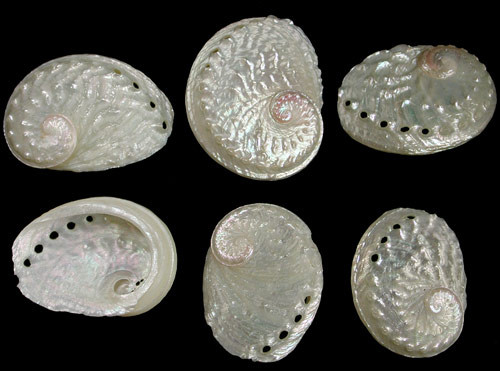
PEARL OVAL ABALONE
Ao-17
One Pearl Oval Polished Abalone 2 to 2 1/2 inch.... OUT OF STOCK
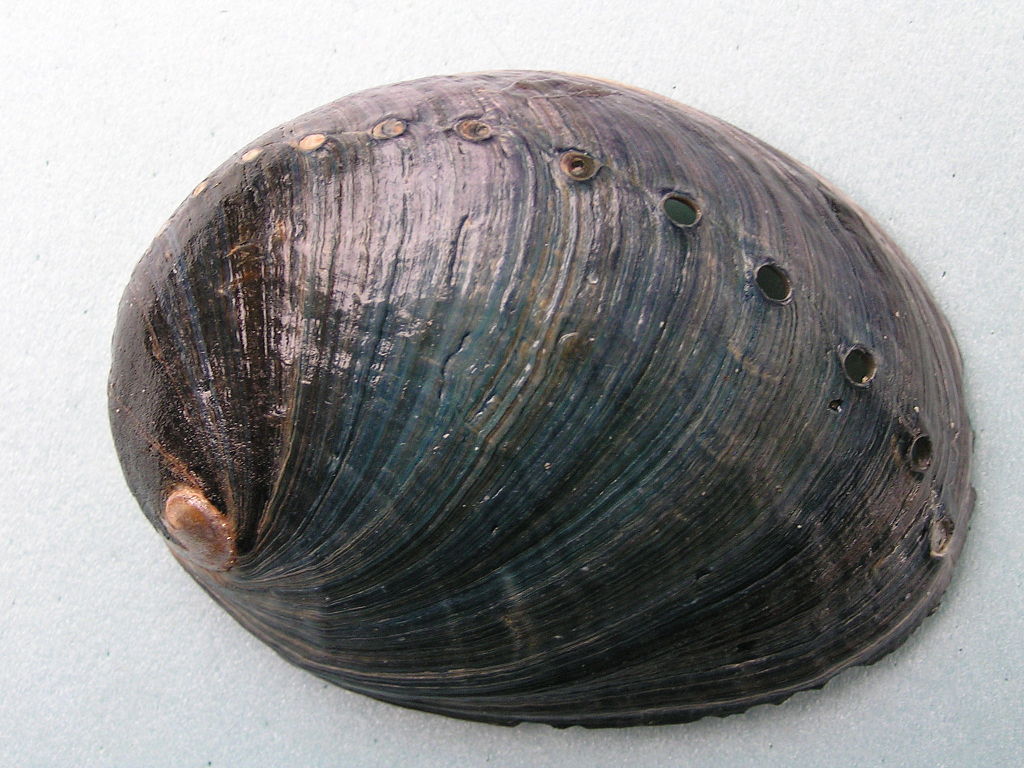
Haliotis Cracherodii Abalone
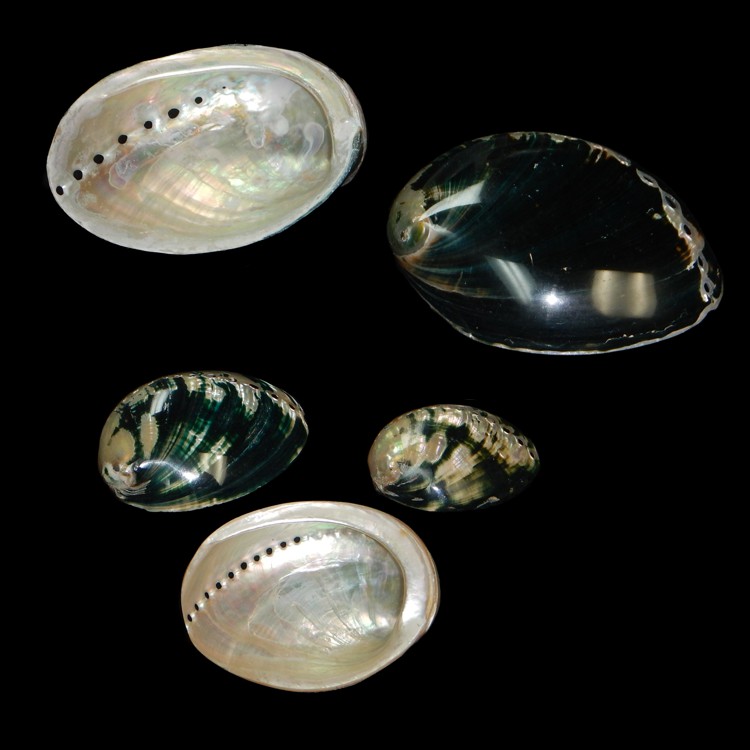
Haliotis Cracherodii Abalone
Haliotis cracherodii, common name the black abalone, is a species of large edible sea snail, a marine gastropod mollusk in the family Haliotidae>
Haliotis Cracherodii coloration is dark brown, dark green, dark blue or almost black. The silvery interior of the shell shows a pale pinkish and greenish iridescence. The exterior of the shell is smoother than most abalones, or may have low obsolete coarse spiral lirae and lines of growth. The shell is oval, evenly convex, the two sides equally curved. The back of the shell is regularly convex, with little algal growth. The shell is not carinated at the row of holes. The spire is near the margin. The cavity of the spire is minute, concealed or nearly so. The muscle scar is generally not distinct. There are usually five to seven small, open respiratory holes, or pores, along the left side of the shell and the rims of the holes are flush with the rest of the shell. These holes collectively make up what is known as the selenizone which form as the shell grows. The columellar plate is not truncate below, sloping inward, its face concave. The rear of the shell is spiraled, and the mantle, foot and tentacles are black. The interior of the shell is pearly with pink and green iridescence.
Lirae are fine lines or ridges (much finer than ribs) that are a sculptural feature of the outside of the shell.
The black abalone's shell length can reach a maximum of 8 inches, the average length ranges from 4 to 5.5 inches.
In the living animal, the tentacles on the epipodium, the mantle, and the foot are black.
Black abalones dwell along the Pacific coast of the United States from Mendocino County, California to Cabo San Lucas, Baja California, Mexico.
Black Abalones cling to rocky surfaces in the low intertidal zone, up to 6 m deep. They can typically be found wedged into crevices, cracks, and holes during low tide. They generally occur in areas of moderate to high surf. Juveniles tend to reside in crevices to reduce their risk of predation, but the larger adults will move out onto rocky surfaces.
Predation is a biological interaction where one organism, the predator, kills and eats another organism, its prey.
Black abalone reach sexual maturity at 3 years and can live 30 years or more. Spawning occurs in spring and early summer; , a second spawn can occur in the fall. Black abalones are broadcast spawners, and successful spawning requires that individuals be grouped closely together. Larvae are free-swimming for 5 to 14 days before they settle onto hard substrates, usually near larger individuals, where they then metamorphose into their adult form, develop a shell and settle on a rock. Juveniles do not tend to disperse great distances, and current populations of black abalone are generally composed of individuals that were spawned locally. Juveniles settle in crevices and remain hidden until they reach about 4 inches in length. At that point, adults congregate in more exposed areas such as rocks and in tide pools. They have been known to live for 25 and 75 years, and will begin to reproduce between three and seven years.
Black abalones are herbivorous gastropods, and feed mostly on drift algae and kelp.
Predators of this species other than mankind are sea otters, fish (such as the California sheephead), and invertebrates, including crustaceans such as the striped shore crab.
Black abalone are listed on the International Union for Conservation of Nature's Red List as Critically Endangered (CR A4e). On June 23, 1999, the U.S. National Marine Fisheries Service (NMFS) designated the black abalone as a candidate for protection under the Endangered Species Act (64 FR 33466). On December 21, 2006, the Center for Biological Diversity submitted a petition to NMFS to list the black abalone. On January 11, 2008, NMFS completed their status review of the species and proposed that it be listed as endangered. Black abalones were listed as endangered on January 14, 2009. The NMFS designated critical habitat for the endangered black abalone on October 27, 2011. The state of California has introduced an Abalone Recovery Management Plan to guide conservation efforts.
Scientific classification
Domain: Eukaryota
Kingdom: Animalia
Phylum: Mollusca
Class: Gastropoda
Subclass: Vetigastropoda
Order: Lepetellida
Family: Haliotidae
Genus: Haliotis
Species: Hliotis cracherodii
Binomial name: Haliotis cracherodii
Leach, 1814
(REF: Peters, H. & Rogers-Bennett, L. (2021). "Haliotis cracherodii". IUCN Red List of Threatened Species. 2021)(REF:Haliotis cracherodii Leach, 1814. Retrieved through: World Register of Marine Species on 5 October 2010)(REF:Oliver, A. P. H. (1975). The Hamlyn Guide to Shells of the World. The Hamlyn Publishing Group Limited.)(REF: George Washington Tryon, Manual of Conchology vol. XII)(REF:Black Abalone (Haliotis cracherodii)". National Marine Fishery Services – Threatened & Endangered Species. NOAA.)(REF: Smith, G., Stamm, C. & Petrovic, F. (2003). Haliotis cracherodii. The IUCN Red List of Threatened Species. Version 2014)(REF:VanBlaricom, Glenn et al. (January, 2009) Status Review Report for Black Abalone (Haliotis cracherodii Leach, 1814). National Oceanic and Atmospheric Administration, National Marine Fisheries Service)(REF:)(REF: Geiger D.L. & Poppe G.T. (2000). A Conchological Iconography: The family Haliotidae. Conchbooks, Hackenheim Germany)
PBA2-5
One Black Polished Abalone 3 to 5 inch.... OUT OF STOCK
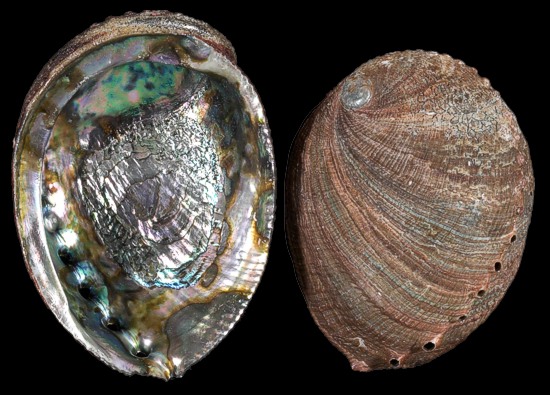
BGA1-7
One Blue Green Abalone measuring 5 to 6 inches.....$16.25
BGA2-7
One One Blue Green Abalone measuring 6 to 7 inch measuring 6 to 7 inches.....$19.95
Abalone is a common name for any of a group of small to very large marine gastropod mollusks in the family Haliotidae. Other common names are ear shells, sea ears, and, rarely, muttonfish or mutton shells in parts of Australia, ormer in the UK, perlemoen in South Africa, and pāua in New Zealand.
Abalones are marine snails. Their taxonomy puts them in the family Haliotidae, which contains only one genus, Haliotis, which once contained six subgenera. These subgenera have become alternative representations of Haliotis. The number of species recognized worldwide ranges between 30 and 130 with over 230 species-level taxa described. The most comprehensive treatment of the family considers 56 species valid, with 18 additional subspecies.
The shells of abalones have a low, open spiral structure, and are characterized by several open respiratory pores in a row near the shell's outer edge. The thick inner layer of the shell is composed of nacre (mother-of-pearl), which in many species is highly iridescent, giving rise to a range of strong, changeable colors which make the shells attractive to humans as decorative objects, jewelry, and as a source of colorful mother-of-pearl.
The flesh of abalones is widely considered to be a desirable food, and is consumed raw or cooked by a variety of cultures.
(REF: Geiger, Daniel L.; Groves, Lindsey T. (September 1999). "Review of Fossil Abalone (Gastropoda, Vetigastropoda, Haliotidae) with Comparison to Recent Species". Journal of Paleontology. 73) (REF:Linnaeus, Carl (1758). Systema Naturæ per Regna Tria Naturæ, Secundum Classes, Ordines, Genera, Species, cum Characteribus, Differentiis, Synonymis, Locis [The System of Nature Through the Three Kingdoms of Nature, According to Classes, Orders, Genera, Species, With the Characteristics, Differences, Synonyms, and Locations] ) (REF: Beesley, P. L.; Ross, G. J. B.; Wells, A. (1998). Mollusca: The Southern Synthesis: An Essential Reference. Melbourne, Australia:)
Most abalones vary in size from 1 inch (Haliotis pulcherrima) to 8 inches. The largest species, Haliotis rufescens, can grow to 12 inches
The shells of abalones are convex, rounded to oval in shape, and may be highly arched or very flattened. The shell of the majority of this species has a small, flat spire and two to three whorls. The last whorl, known as the body whorl, is auriform, meaning that the shell resembles an ear, giving rise to the common name "ear shell". Haliotis asinina has a somewhat different shape, as it is more elongated and distended. The shell of Haliotis cracherodii cracherodii is also unusual as it has an ovate form, is imperforate, shows an exserted spire, and has prickly ribs.
ovate shaped like an egg.
A mantle cleft in the shell impresses a groove in the shell, in which are the row of holes characteristic of the genus. These holes are respiratory apertures for venting water from the gills and for releasing sperm and eggs into the water column. They make up what is known as the selenizone, which forms as the shell grows. This series of 8 to 38 holes is near the anterior margin. Only a small number is generally open. The older holes are gradually sealed up as the shell grows and new holes form. Each species has a typical number of open holes, between four and 10, in the selenizone. An abalone has no operculum. The aperture of the shell is very wide and nacreous.
convex is defined as curved or bowed outward like the outside of a bowl, circle, or sphere.
operculum is a corneous or calcareous anatomical structure like a trapdoor.
A mantle refers to a robe or cloak, it is a significant part of the anatomy of mollusks: it is the dorsal body wall which covers the visceral mass and usually protrudes in the form of flaps well beyond the visceral mass itself.
The exterior of the shell is striated and dull. The color of the shell is very variable from species to species, which may reflect the animal's diet. The iridescent nacre that lines the inside of the shell varies in color from silvery white, to pink, red and green-red to deep blue, green to purple.
The animal has fimbriated head lobes and side lobes that are fimbriated and cerrated. The radula has small median teeth, and the lateral teeth are single and beam-like. They have about 70 uncini, with denticulated hooks, the first four very large. The rounded foot is very large in comparison to most mollusks. The soft body is coiled around the columellar muscle, and its insertion, instead of being on the columella, is on the middle of the inner wall of the shell. The gills are symmetrical and both well developed.
fimbriated means having a border of hairs or filiform processes.
These snails cling solidly with their broad, muscular foot to rocky surfaces at sublittoral depths, although some species such as Haliotis cracherodii used to be common in the intertidal zone.
Abalones reach maturity at a relatively small size. Their fecundity is high and increases with their size, laying from 10,000 to 11 million eggs at a time. The spermatozoa are filiform and pointed at one end, and the anterior end is a rounded head.
The adults provide no further assistance to the larvae and they are described as lecithotrophic. The adults are herbivorous and feed with their rhipidoglossan radula on macroalgae, preferring red or brown algae.
radula is an anatomical structure used by mollusks for feeding, sometimes compared to a tongue. It is a minutely toothed, chitinous ribbon, which is typically used for scraping or cutting food before the food enters the esophagus. The radula is unique to the mollusks, and is found in every class of mollusk except the bivalves, which instead use cilia, waving filaments that bring minute organisms to the mouth.
(REF: Hoiberg, Dale H., ed. (1993). "The New Encyclopaedia Britannica". Encyclopædia Britannica. Vol. 1) (REF: Anderson, Jenny (2003). "Abalone Introduction") (REF: Tryon, George W. Jr. (1880). Manual of Conchology; Structural and Systematic With Illustrations of the Species)
The haliotid family has a worldwide distribution, along the coastal waters of every continent, except the Pacific coast of South America, the Atlantic coast of North America, the Arctic, and Antarctica. The majority of abalone species are found in cold waters, such as off the coasts of New Zealand, South Africa, Australia, Western North America, and Japan.
(REF: Anon (2014). "Abalone Viral Ganglioneuritis". Department of Primary Industries, Parks, Water and Environment. Tasmanian Government.) (REF: Leatherman, Stephen (2012). National Geographic Field Guide to the Water's Edge. National Geographic Field Guides
The shell of the abalone is exceptionally strong and is made of microscopic calcium carbonate tiles stacked like bricks. Between the layers of tiles is a clingy protein substance. When the abalone shell is struck, the tiles slide instead of shattering and the protein stretches to absorb the energy of the blow. Material scientists around the world are studying this tiled structure for insight into stronger ceramic products such as body armor. The dust created by grinding and cutting abalone shell is dangerous; appropriate safeguards must be taken to protect people from inhaling these particles
(REF: Lin, Albert; Meyers, Marc André (15 January 2005). "Growth and Structure in Abalone Shell". Materials Science and Engineering: ) (REF: Hypersensitivity Pneumonitis". www.clevelandclinicmeded.com)
Scientific classification
Domain: Eukaryota
Kingdom: Animalia
Phylum: Mollusca
Class: Gastropoda
Subclass: Vetigastropoda
Order: Lepetellida
Family: Haliotidae
Rafinesque, 1815
Genus: Haliotis
Linnaeus, 1758[2][3]
Type species: Haliotis asinina
Linnaeus, 1758